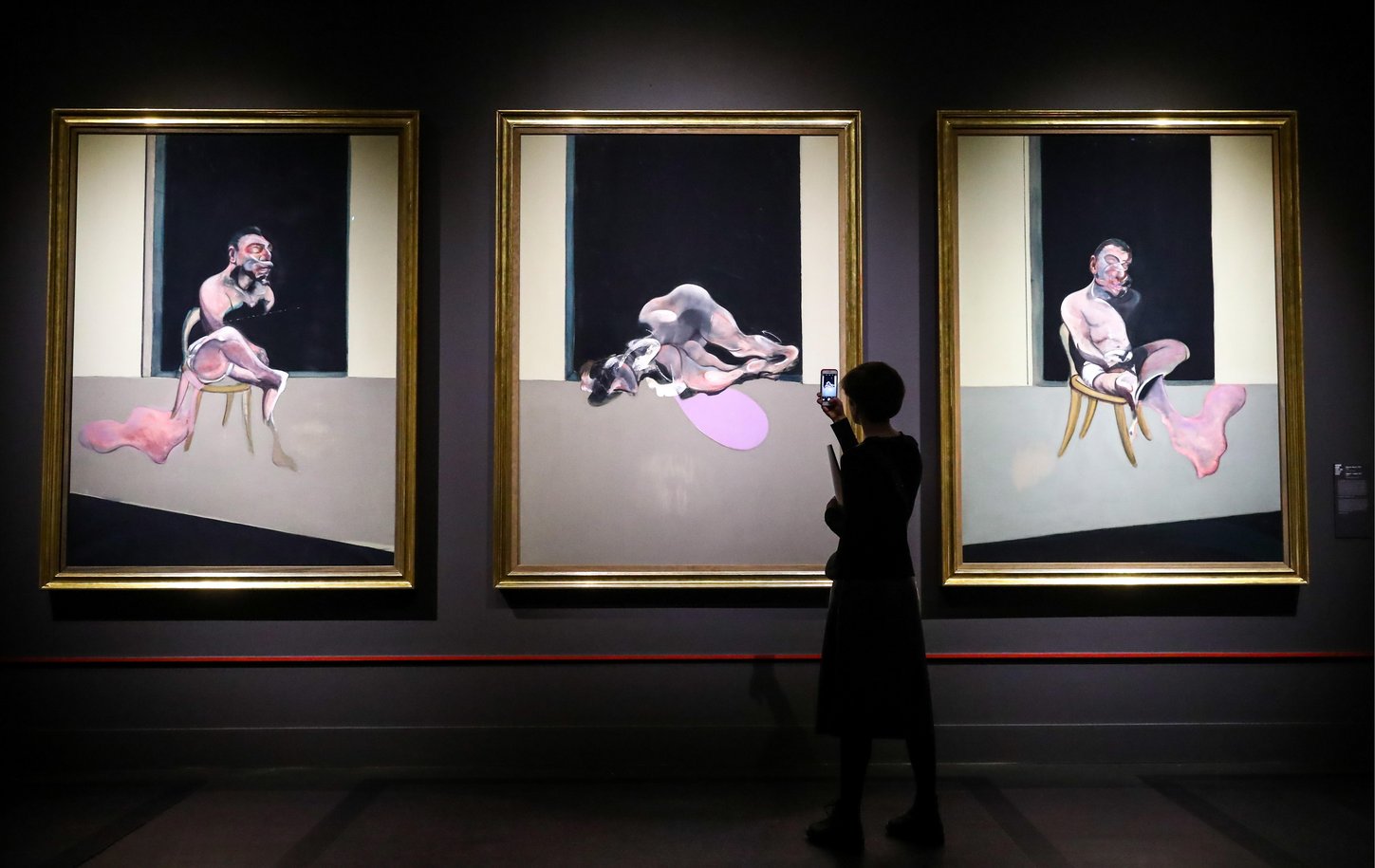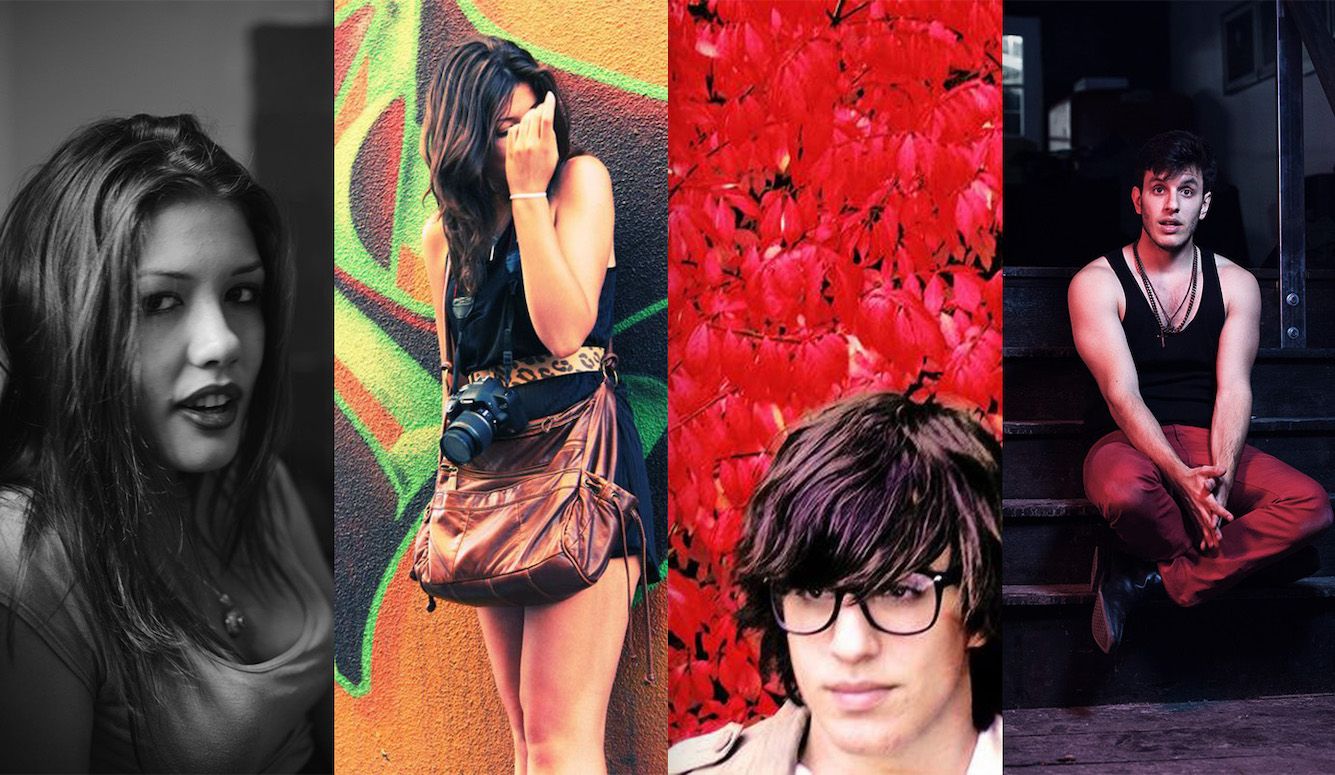Art
Francis Bacon’s Very, Very Ordered Chaos
Dyer hated the way Bacon painted him and watched with incredulity as rich collectors bought one huge, violently distorted portrait after another.

At least as recently as 1989, the catalogue for a traveling retrospective on the Anglo-Irish painter Francis Bacon could get away with referring to his lover and frequent model George Dyer as “a close friend.” More recent documentary portrayals, including a 2005 BBC Arena episode and Francis Bacon: A Brush with Violence (2017), have dispensed with such discretion about Dyer and his suicide by barbiturates, which was timed perfectly to spoil the opening of Bacon’s 1971 retrospective at Paris’s Grand Palais—the second given to a living artist (after Bacon’s hero Picasso), and the first to a British one. Viewers learned that Dyer, a young tough from London’s East End whom Bacon met in 1963, turned out to be “rather reticent with the whip, so little by little Francis became disabused,” according to one friend. Bacon “wanted George to rape him, and George wanted to cuddle,” another friend confides. Yet another: “George was suffering from erectile dysfunction. It seems to me that Francis emasculated him.”
Or as the Museum of Fine Arts, Houston more tactfully puts it on a wall text for the exhibition Francis Bacon: Late Paintings, on view through May 25th: “Bacon initially was drawn to Dyer’s virility, naiveté, and working-class background, but by 1971 their relationship had soured.” The didactics acknowledge Dyer’s suicide two days before the Grand Palais opening—and its recurring impact on Bacon’s work over the next decade—but omit the most shocking detail: that Bacon, some friends, and the manager of the Paris hotel where Dyer died hid his body, which had been found on the toilet, for two days before reporting his death so the opening could proceed as planned. As if that weren’t enough, the French state had recently purchased a 1964 Bacon triptych—not on view in the Houston exhibition—that included a panel presciently featuring Dyer on, yes, a toilet. At the Grand Palais opening, President Georges Pompidou paused before the triptych to chat with Bacon, who appears in the documentary footage sporting a herpes blister on his lip and splitting the difference between smiling and wincing at each pleasantry.
Museum shows have different aims from tell-all documentaries, and there’s no one-size-fits-all answer to the question of how much biographical information is too much. But if you consider the story of Bacon’s remarkably compartmentalized response to Dyer’s overdose alongside something he said 20 years later, in his final interview—“I like a very, very ordered chaos”—you’re well on your way to understanding the works in Francis Bacon: Late Paintings, which traveled to Houston from Paris’s Centre Pompidou, where it debuted last fall. Mostly consisting of works made between Dyer’s death in 1971 and Bacon’s in 1992, the show also features a handful of canvases from the late Sixties, including Portrait of George Dyer in a Mirror (1968), which features some of Bacon’s most sensuous handling of paint and his typically brutal handling of Dyer.

Dyer sits in a mostly empty interior, wearing a business suit and clutching a cigarette butt in his melting hand, and contemplates his reflection, which turns, in profile, away instead of looking back at him. Dyer’s reflection, with its raw-meat (or flayed-carcass) flesh tones and torn-and-carelessly-reassembled appearance, makes the mirror resemble one of the countless photos Bacon kept around his emphatically messy studio, referring not only to their imagery but to the damage they accumulated. Live models, he told the critic David Sylvester, “inhibit me, because if I like them, I don’t want to practice the injury that I do to them in my work before them. If I like them, I would rather practice the injury in private.”
Dyer hated the way Bacon painted him and watched with incredulity as rich collectors bought one huge, violently distorted portrait after another. “He thinks I look like that?” Dyer asked a mutual friend. Sylvester, who dubbed Bacon “the religious painter of an atheistic age,” had questions of his own. “Do you not think that the marks you’re making are both a caress and a blow, an assault?” he asked. “Possibly,” Bacon replied. Sylvester persisted: “But don’t you think that your sitter instinctively sees this as an injury, which in a sense might be thought naive, but I’m suggesting the instinct is right, that they’re realizing what is really going on.” “It may be,” Bacon replied with bone-chilling prescience, “but what you’re really saying is that, while sad, you kill the thing you love.”
Dyer, who was the second of Bacon’s lovers to die on the eve of a retrospective—the dashing but violently sadistic Peter Lacy died as Bacon’s 1962 Tate survey was opening—remained a recurring figure in Bacon’s work for a decade. The left panel of the 1971 triptych In Memory of George Dyer depicts his death throes, though Bacon used one of Eadweard Muybridge’s photographs of wrestlers as the reference, as he also often did to suggest male coupling. The whorls and smears of paint, loaded with connotations of eroticism, violence, or both, shove Bacon’s imagery in your face while leaving a surprising amount to the imagination. “I always think of myself not so much as a painter but as a medium for accident and chance,” said Bacon, a hard drinker and frequent gambler.
For this month’s Catalogue Raisonné Focus, and in honour of #ValentinesDay, we take a closer look at a triptych featuring one of #FrancisBacon's former great loves, In Memory of George Dyer, 1971: https://t.co/oWEOPjQ40p pic.twitter.com/1uqgdhzQ7D
— Francis Bacon (@francisbacon) February 14, 2019
Even in the show’s goriest (but also most sumptuous and lushly colored) picture, Triptych (1967)—first exhibited with the subtitle “Inspired by T.S. Eliot’s Sweeney Agonistes” which Bacon later disavowed—both the sadomasochism of the outer panels and the bloody murder scene at center are so engulfed in abstraction that they are more implicit than explicit. (The object label quotes Eliot: “Birth, and copulation, and death. / That’s all, that’s all, that’s all, that’s all, / Birth, and copulation, and death.”)
The 1967 triptych seems to be crammed with narrative detail compared to most of what came later. Dyer’s body is increasingly consumed by Bacon’s spare, simple backgrounds while dissolving into puddles in Triptych August 1972, Triptych 1974–77—an ominous beach scene, deviating from Bacon’s usual interiors and anticipating a new foray into abstract landscapes, several of which hang nearby—and Study for Portrait (1981). Bacon treats his own form and features similarly in works like Self-Portrait (1973) and Study for Self-Portrait (1976). “I loathe my own face, but I go on painting it, only because I haven’t got any other people to do,” Bacon said.
To mark Francis Bacon’s 110th birthday, here is his Self-Portrait, 1972. pic.twitter.com/MJgHW7SeMY
— Francis Bacon (@francisbacon) October 28, 2019
By the mid-to-late 1980s, Bacon had a new young “close friend”—a former bartender named John Edwards, who was less self-destructive (and better at setting boundaries and sticking up for himself) than Dyer. Edwards already had a boyfriend and kept his affair with Bacon passionate but platonic; according to the critic and biographer Mark Stevens, their relationship “was paternal, but it’s not always clear who’s the father and who’s the son.”
Still, like Dyer, Edwards complained about how Bacon depicted him, asking, “Why the fuck do you make me look like a monkey in all your paintings?” These portraits were arguably less violent in their distortions than most of Bacon’s earlier works had been, but that is not to say they are any less existential. Although the screams and anguished faces that brought Bacon fame (and which precede the body of work on view in Houston) are long gone, it remains true that, as Rina Arya has written, figures “are not anchored in space by gravity, shadows are more opaque than the figures themselves, mirrors dissolve images, and bodies twist and turn around each other until they dissolve into matter.”
Bacon, who maintained that “it’s always nicer to do portraits of people whose looks you really like,” would always laugh at Edwards’ question but never answer. But in the Sixties, he’d told his friend Michael Peppiatt, “I’m only trying to deform into truth. After all, photography has done so much, so how are you to make a portrait nowadays unless you can bring what’s called the facts of someone’s appearance more directly and violently back on to the nervous system?”
Note the combination of directness and distancing—not simply “the facts” but “what’s called the facts”—in that last sentence. The words are like those bare outlines, suggestive of Plexiglas cases for sculptures, that contain Bacon’s writhing bodies, dangling meat carcasses, charging bulls, and oozing anthropomorphic landscapes—each under glass, neatly framed in gold. Bacon used similarly candid yet distancing language around sexuality, often referring to himself as “what’s called a queer” (in the pre-reclamation sense of the word) or “what you might call completely homosexual.” And oddly for a sex-and-death-obsessed, completely homosexual artist who died in 1992, the AIDS pandemic seems not to have penetrated Bacon’s orbit during his final decade, at least not enough to factor into any interviews or discussions of his work that I could find. Then again, museums were still calling Dyer his “close friend”—like Bacon, they preferred, in their own way, a very, very ordered chaos. Now their websites link to listicles touting Francis Bacon: Late Paintings as one of “16 LGBTQ art shows worth traveling for.”
Worth traveling for? Absolutely, under normal conditions, although the COVID-19 pandemic probably means you’re better advised to content yourself with ordering the catalogue and binge-watching the many Bacon interviews and documentaries available on YouTube. But while you might call Bacon—who camped it up with the best of them while checking plenty of “toxic masculinity” boxes—completely homosexual, you can’t call him or this show LGBTQ without imposing a phony and sanitized order on his unsavory, defiantly politically incorrect and virulently existential chaos.






